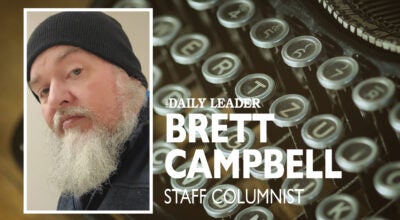A different kind of memorial: Part 1
Published 9:35 pm Tuesday, October 23, 2018
Alabama is no stranger to a triple-digit heat index. It’s what makes the cotton grow and what brings tourists to its beaches. Even so, on Coosa Street in downtown Montgomery this August, visitors waiting to enter the new Legacy Museum appeared ill-prepared for the stifling temperatures. Daughter No. 2 and I watched as they fanned themselves with brochures collected from the visitor’s bureau and rolled up their shirt sleeves. A few blocks away, the heat also worked on ticket holders at the National Memorial for Peace and Justice. In that outdoor structure, history—the full weight of it—hung as heavy as the humidity.
And that’s the point. Some 800 coffinlike monuments suspend in the pavilion, airing out centuries of racial grievances. They’re fashioned from corten steel, a brown-toned material that seems to bleed as it ages, and they’re engraved with the details of more than 4,000 lynchings, making tangible what organizers call “invisible history.” The lynching memorial opened in April, along with its twin museum. Together, they attempt to connect the historical dots between U.S. slavery, segregation, and injustice.
Harvard Law School graduate Bryan Stevenson provided the momentum for both projects through a nonprofit legal group he founded in 1989 called the Equal Justice Initiative (EJI). He says lynchings weren’t just brutal footnotes in history but rather reflected a belief system: “The great evil of American slavery wasn’t involuntary servitude and forced labor. It was this ideology of white supremacy, this narrative of racial difference. That’s the narrative we haven’t actually come to grips with. That was the true toxin that poisoned our nation.”
Toxin trouble is nothing new in Montgomery. Known as the cradle of the Confederacy, the city was once the capital of the domestic slave trade in Alabama. Later, Montgomerians jailed Rosa Parks and bombed Martin Luther King Jr.’s home. Still, EJI purposefully headquartered in the city. Last year, while riots raged over Confederate monuments two states away in Charlottesville, Va., a different type of memorial was taking shape in Montgomery, one that shows the evils of racial sin. Stevenson points out the problem of romanticizing pockets of the past: “My goal is to create a deeper understanding of our history so we understand what’s appropriate to honor and what’s not appropriate to honor.”
The designers of the lynching memorial expect that kind of understanding to come incrementally. Upon entry, visitors encounter the hanging 6-foot monuments at eye level, but as they turn into the next corridor and the next, the columns rise overhead. The effect is meant to convey the scale of terror: “Lynching was gratuitous,” Stevenson says. “They didn’t have to hang people and lift those bodies up, but they did it because they wanted to traumatize and taunt communities of color.”
While the memorial’s design is visually arresting, the entries etched on the columns are not. They’re understated, like the scant 24 characters on the Jones County monument that reference the lynching of John Hartfield. To learn Hartfield’s back story, visitors must see exhibits at the 11,000-square-foot Legacy Museum. One of its walls displays a headline from the June 26, 1919, edition of the New Orleans States (now the Times-Picayune): “John Hartfield Will Be Lynched by Ellisville Mob at 5 O’clock This Afternoon.” Yards away, a jar of soil from Hartfield’s lynching site sits among hundreds of others collected as part of EJI’s Community Remembrance Project. In another spot, videos document the details of Hartfield’s brutal, extrajudicial hanging—the 10,000 spectators, the food vendors, the photo postcards, the souvenir amputated fingers.
Ellisville pastor Luke Johnson, 35, only learned of John Hartfield after the Legacy Museum opened. When he polled a few members of First Baptist Church, he discovered no one else had heard of Hartfield either. The lynching was, as the EJI purports, invisible history.
Johnson couldn’t shake the story. “I started asking around, doing research. What I found was that by the second generation, the people of Ellisville had stopped talking about Mr. Hartfield.” He believes the whole matter had been swept under the rug. “They became complicit. No righteous man stood up.”
As Johnson studied Biblical examples of community confession led by Ezra and Daniel, he began to consider the effects of generational sin on his congregation. “I can’t help but wonder if we’ve been swallowing a camel for 99 years while we’ve strained out gnats,” he acknowledges.
Johnson plans to reach out to other pastors in the area about addressing these issues and asking for God’s mercy and forgiveness. He believes that’s Biblical: “I could live the rest of my life ignoring John Hartfield, but that would be sin. Pastors would be wise to know the history where they serve. If there’s glaring sin in the community, then they’re God’s representatives to deal with it.”
Organizers at the new lynching memorial hope that “dealing with it” includes acknowledgment, and that’s why they included a nonstatic element in their plans. Duplicate monuments, with the same dimensions and engravings as those in the pavilion, line walkways in a parklike portion of the grounds. Communities can work with EJI to claim and install them in their respective counties across the United States. Whether over time the monuments leave Montgomery—or don’t—may become the most telling exhibit of all.
Kim Henderson is a freelance writer. Contact her at kimhenderson319@gmail.com.





